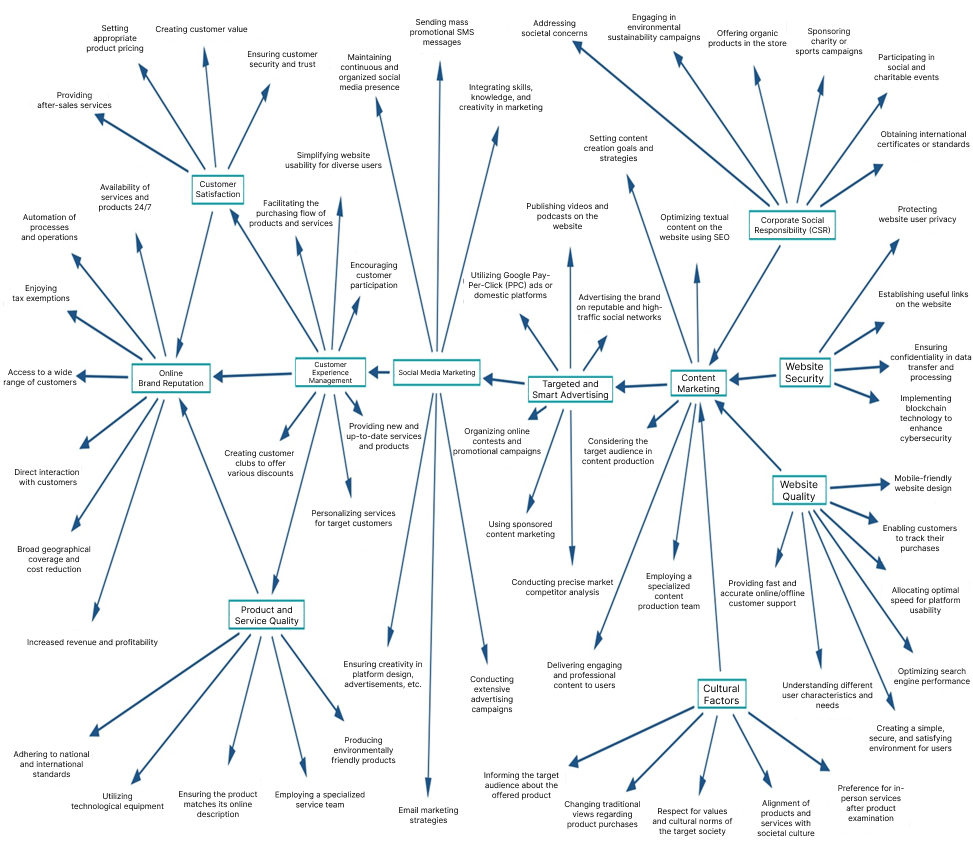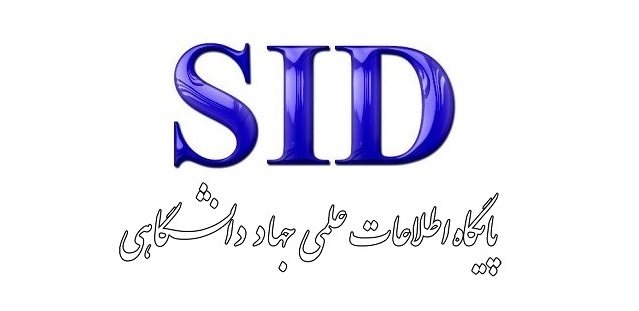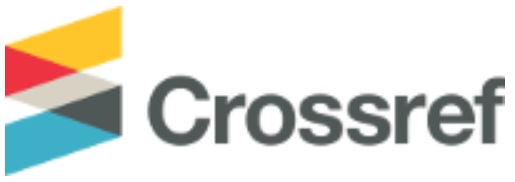Designing a Model for Enhancing the Reputation of Online Brands
Keywords:
Online reputation, Online brand, website qualityAbstract
Online reputation or electronic reputation can be considered one of the most significant intangible assets of companies. The objective of this study is to design a model for enhancing the reputation of online brands. The present research is qualitative in terms of methodology and employs a descriptive-exploratory approach with a phenomenological method for data analysis. The research instrument used in this study is in-depth (semi-structured) interviews. The statistical population consists of 10 experts and specialists in the field of marketing for online brands. In this study, members of the expert panel were selected using a purposive sampling approach. Key codes were extracted through a thematic analysis approach and analyzed using MAXQDA software. The validity of the research findings was assessed and confirmed based on the criteria proposed by Creswell (2002). The results indicated that the categories and components of online brand reputation enhancement include 11 main categories: online brand reputation, cultural factors, customer experience management, website quality, website security, store social responsibility, social media marketing, content marketing, targeted and intelligent advertising, product and service quality, and customer satisfaction, along with 63 subcategories.
References
M. M. Barbato, "Measuring corporate reputation through online social media," 2016. [Online]. Available: https://amslaurea.unibo.it/id/eprint/12434/1/Tesi_Barbato.pdf
K. Parsakia and M. Jafari, "Strategies for Enhancing Customer Engagement Using Artificial Intelligence Technologies in Online Markets," Journal of Technology in Entrepreneurship and Strategic Management (JTESM), vol. 2, no. 1, pp. 49-69, 05/29 2023, doi: 10.61838/kman.jtesm.2.1.6.
M. R. Díaz, C. I. R. Voltes, and A. C. R. Voltes, "Gap analysis of the online reputation," Sustainability Journal, vol. 10, no. 5, p. 1603, 2018. [Online]. Available: https://doi.org/10.3390/su10051603.
E. Portmann, A. Meier, P. Cudré-Mauroux, and W. Pedrycz, "FORA-A fuzzy set based framework for online reputation management," Fuzzy Sets and Systems, vol. 269, pp. 90-114, 2015. [Online]. Available: https://doi.org/10.1016/j.fss.2014.06.004.
M. A. Qureshi, A. Younus, C. O'Riordan, and G. Pasi, "A Wikipedia-based semantic relatedness framework for effective dimensions classification in online reputation management," Journal of Ambient Intelligence and Humanized Computing, vol. 9, pp. 1403-1413, 2018. [Online]. Available: https://doi.org/10.1007/s12652-017-0536-y.
N. Şirzad, "A review on online reputation management and online reputation components," Doğuş Üniversitesi Dergisi, vol. 23, no. 1, pp. 219-242, 2022.
H. S. Manaman, S. Jamali, and A. AleAhmad, "Online reputation measurement of companies based on user-generated content in online social networks," Computers in Human Behavior, vol. 54, pp. 94-100, 2016. [Online]. Available: https://doi.org/10.1016/j.chb.2015.07.061.
W. He, S. Zha, and L. Li, "Social media competitive analysis and text mining: A case study in the pizza industry," International Journal of Information Management, vol. 33, no. 3, pp. 464-472, 2013. [Online]. Available: https://doi.org/10.1016/j.ijinfomgt.2013.01.001.
S. Das and A. Lavoie, "The effects of feedback on human behavior in social media: An inverse reinforcement learning model," in In Proceedings of the 2014 International Conference on Autonomous Agents and Multi-Agent Systems, 2014, pp. 653-660.
J. Wiebe, R. Bruce, and T. P. O'Hara, "Development and use of a gold-standard data set for subjectivity classifications," In Proceedings of the 37th Annual Meeting of the Association for Computational Linguistics, pp. 246-253, 1999. [Online]. Available: https://doi.org/10.3115/1034678.1034721.
M. Hu and B. Liu, "Mining and summarizing customer reviews," in In Proceedings of the Tenth ACM SIGKDD International Conference on Knowledge Discovery and Data Mining, 2004, pp. 168-177. [Online]. Available: https://doi.org/10.1145/1014052.1014073.
J. Ortigosa-Hernández, J. D. Rodríguez, L. Alzate, M. Lucania, I. Inza, and J. A. Lozano, "Approaching sentiment analysis by using semi-supervised learning of multi-dimensional classifiers," Neurocomputing, vol. 92, pp. 98-115, 2012. [Online]. Available: https://doi.org/10.1016/j.neucom.2012.01.030.
E. Haddi, X. Liu, and Y. Shi, "The role of text pre-processing in sentiment analysis," Procedia Computer Science, vol. 17, pp. 26-32, 2013. [Online]. Available: https://doi.org/10.1016/j.procs.2013.05.005.
C. Tan, L. Lee, J. Tang, L. Jiang, M. Zhou, and P. Li, "User-level sentiment analysis incorporating social networks," in In Proceedings of the 17th ACM SIGKDD International Conference on Knowledge Discovery and Data Mining, 2011, pp. 1397-1405. [Online]. Available: https://doi.org/10.1145/2020408.2020614.
P. H. Calais Guerra, A. Veloso, W. Meira Jr, and V. Almeida, "From bias to opinion: a transfer-learning approach to real-time sentiment analysis," in In Proceedings of the 17th ACM SIGKDD International Conference on Knowledge Discovery and Data Mining, 2011, pp. 150-158. [Online]. Available: https://doi.org/10.1145/2020408.2020438.
A. Davies and Z. Ghahramani, "Language-independent Bayesian sentiment mining of Twitter," in In The 5th SNA-KDD Workshop, 2011, vol. 11.
N. Hosseini and S. R. Hosseini, "Designing a model of organizational reputation for the insurance industry with an emphasis on identifying and ranking influential factors on reputation," Insurance Research Journal, vol. 13, no. 2, pp. 87-100, 2024.
W. Vollenbroek, S. De Vries, E. Constantinides, and P. Kommers, "Identification of influence in social media communities," International Journal of Web Based Communities, vol. 10, no. 3, pp. 280-297, 2014. [Online]. Available: https://doi.org/10.1504/IJWBC.2014.062943.
F. Yeganeh Rad, A. Lowa, and S. Amiri, "Examining the role of dimensions of corporate social responsibility on brand reputation perception and brand equity," Prospects of Accounting and Management, vol. 6, no. 85, pp. 204-213, 2023.
J. H. Kietzmann, K. Hermkens, I. P. McCarthy, and B. S. Silvestre, "Social media? Get serious! Understanding the functional building blocks of social media," Business Horizons, vol. 54, no. 3, pp. 241-251, 2011. [Online]. Available: https://doi.org/10.1016/j.bushor.2011.01.005.
P. R. Berthon, L. F. Pitt, I. McCarthy, and S. M. Kates, "When customers get clever: Managerial approaches to dealing with creative consumers," Business Horizons, vol. 50, no. 1, pp. 39-47, 2007. [Online]. Available: https://doi.org/10.1016/j.bushor.2006.05.005.
M. S. Akin, "Enhancing e-commerce competitiveness: A comprehensive analysis of customer experiences and strategies in the Turkish market," Journal of Open Innovation: Technology, Market, and Complexity, vol. 10, no. 1, p. 100222, 2024, doi: https://doi.org/10.1016/j.joitmc.2024.100222.
Y. Duan, "Factors Influencing E-Commerce Live-Streaming Shopping Customers Purchase Intention in Malaysia: A Conceptual Paper," Advances in Economics Management and Political Sciences, vol. 93, no. 1, pp. 19-30, 2024, doi: 10.54254/2754-1169/93/20241104.
M. Nazari and M. Baghdadi, "Identifying and examining the factors influencing impulse online purchases in group discount stores in Iran," Information Technology Management, vol. 5, no. 3, pp. 223-239, 2013.
D. Fernández-Uclés, A. Mozas-Moral, E. Bernal-Jurado, and R. Puentes-Poyatos, "Online reputation of agri-food companies and determining factors: an empirical investigation," Review of Managerial Science, vol. 18, no. 2, pp. 363-384, 2024. [Online]. Available: https://doi.org/10.1007/s11846-023-00639-8.
A. Singh, S. Jain, T. Aswathinath, J. Jayashree, and M. V. Bajaj, "Online Reputation Management: Strategies for Building and Protecting Brand Image," Journal of Propulsion Technology, vol. 44, no. 4, pp. 4490-4497, 2023. [Online]. Available: https://doi.org/10.52783/tjjpt.v44.i4.1698.
V. Dutot and S. Castellano, "Designing a measurement scale for e-reputation," Corporate Reputation Review, vol. 18, pp. 294-313, 2015. [Online]. Available: https://doi.org/10.1057/crr.2015.15.
A. Abbasi Gorji, S. Faiz, and S. Hedayatifar, "Analyzing the factors affecting the use of social software in gaining virtual reputation: A theoretical explanation of the cultivation theory in the media domain," Global Media Journal, vol. 13, no. 2, pp. 151-170, 2018.
I. Malek Akhlagh, M. Akbari, and A. Gholizadeh Kolai, "Brand reputation: Models and measurement methods," in In Proceedings of the First International Conference on Management, Economics, Accounting, and Educational Sciences, 2015: Sari. [Online]. Available: https://civilica.com/doc/445641.
M. Fiaz, A. Ikram, A. Basma, Z. Tariq, S. K. A. Jafri, and W. Khurram, "Role of social media marketing activities in creating university brand image and reputation: The mediating role of customer value co-creation behavior," in In 2019 8th International Conference on Information and Communication Technologies (ICICT), 2019, pp. 135-141. [Online]. Available: https://doi.org/10.1109/ICICT47744.2019.9001927.
D. Ghorbanzadeh and M. Sharbatiyan, "The role of website features in creating value co-creation behaviors and enhancing the brand image and reputation of higher education institutions," Interactive Technology and Smart Education, vol. 21, no. 1, pp. 21-43, 2024. [Online]. Available: https://doi.org/10.1108/ITSE-12-2021-0225.
N. Norouzi and M. Mahmoudzadeh, "The impact of content marketing on increasing sales with the mediation of brand reputation (Case study: Abbasabad Industrial Town)," New Research Approaches in Management Sciences, vol. 3, no. 6, pp. 97-110, 2020.
H. Bazdar, "Strategies for increasing and improving the brand reputation of Sepah Bank's current account," Strategic Studies in Finance and Banking, vol. 2, no. 2, pp. 73-83, 2024.
S. Nabila and A. Albari, "The Influence of Interaction Quality, Physical Environment Quality, and Environmentally Friendly Practices on Brand Personality and Brand Reputation with Customer Experience as a Mediating Variable," Asian Journal of Economics, Business and Accounting, vol. 24, no. 5, pp. 254-268, 2024. [Online]. Available: https://doi.org/10.9734/ajeba/2024/v24i51307.
S. R. Chowdhury, "Building Brand Reputation through Marketing Mix-A Case Study on Philips and Toshiba," Image, vol. 9, no. 8, 2017.
D. N. Rahma and M. Nasir, "Understanding Brand Loyalty: The Impact of Brand Reputation, Corporate Reputation, and Brand Experience with Mediating Satisfaction on Skincare Facetology," Jurnal Orientasi Bisnis dan Entrepreneurship, vol. 5, no. 2, pp. 150-162, 2024. [Online]. Available: https://doi.org/10.33476/jobs.v5i2.4855.
N. A. A. Azham and T. A. H. D. T. Ahmad, "Brand reputation management and brand experience towards reputation of Malaysian polytechnics," Jurnal Intelek, vol. 15, no. 1, pp. 98-106, 2020. [Online]. Available: https://doi.org/10.24191/ji.v15i1.272.

Downloads
Published
Submitted
Revised
Accepted
Issue
Section
License
Copyright (c) 2025 Management Strategies and Engineering Sciences

This work is licensed under a Creative Commons Attribution-NonCommercial 4.0 International License.











